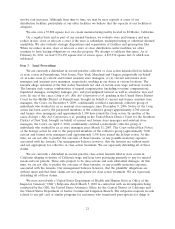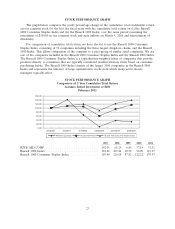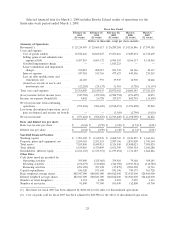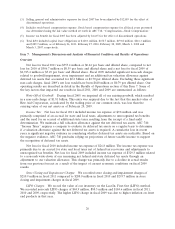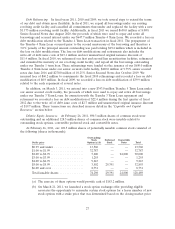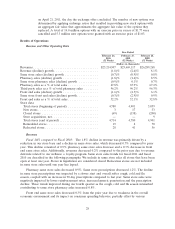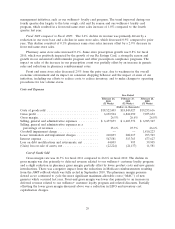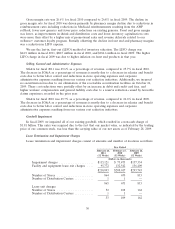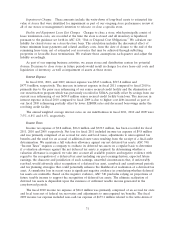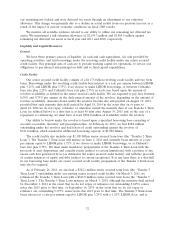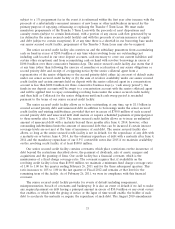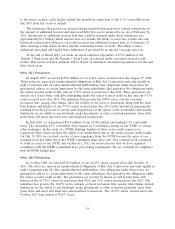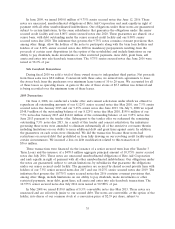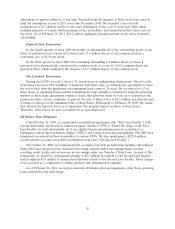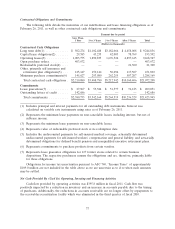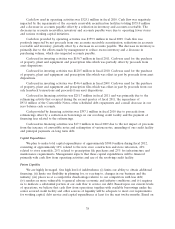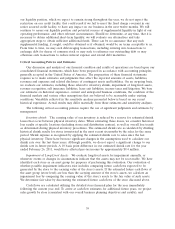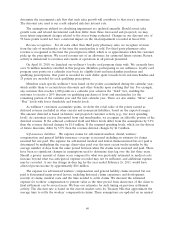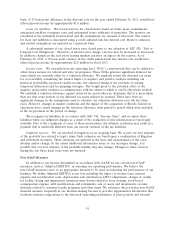Rite Aid 2011 Annual Report Download - page 31
Download and view the complete annual report
Please find page 31 of the 2011 Rite Aid annual report below. You can navigate through the pages in the report by either clicking on the pages listed below, or by using the keyword search tool below to find specific information within the annual report.Impairment Charges. These amounts include the write-down of long-lived assets to estimated fair
value at stores that were identified for impairment as part of our on-going store performance review at
all of our stores or management’s intention to relocate or close a specific store.
Facility and Equipment Lease Exit Charges. Charges to close a store, which principally consist of
lease termination costs, are recorded at the time the store is closed and all inventory is liquidated,
pursuant to the guidance set forth in ASC 420, ‘‘Exit or Disposal Cost Obligations.’’ We calculate our
liability for closed stores on a store-by-store basis. The calculation includes the discounted effect of
future minimum lease payments and related ancillary costs, from the date of closure to the end of the
remaining lease term, net of estimated cost recoveries that may be achieved through subletting
properties or favorable lease terminations. We evaluate these assumptions each quarter and adjust the
liability accordingly.
As part of our ongoing business activities, we assess stores and distribution centers for potential
closure. Decisions to close stores in future periods would result in charges for store lease exit costs and
liquidation of inventory, as well as impairment of assets at these stores.
Interest Expense
In fiscal 2011, 2010, and 2009, interest expense was $547.6 million, $515.8 million and
$477.6 million, respectively. The increase in interest expense in fiscal 2011 compared to fiscal 2010 is
primarily due to the prior year refinancing of our senior secured credit facility and the elimination of
our securitization program which was previously recorded in SG&A, partially offset by savings from our
current year refinancing of our $650.0 million senior secured credit facility term loan. The increase in
interest expense in fiscal 2010 compared to fiscal 2009 is due to higher cost debt incurred as part of
our fiscal 2010 refinancing partially offset by lower LIBOR rates and decreased borrowings under the
revolving credit facility.
The annual weighted average interest rates on our indebtedness in fiscal 2011, 2010 and 2009 were
7.5%, 6.8% and 6.6%, respectively.
Income Taxes
Income tax expense of $9.8 million, $26.8 million and $329.3 million, has been recorded for fiscal
2011, 2010 and 2009, respectively. Net loss for fiscal 2011 included income tax expense of $9.8 million
and was primarily comprised of an accrual for state and local taxes, adjustments to unrecognized tax
benefits and the need for an accrual of additional state taxes resulting from the receipt of a final audit
determination. We maintain a full valuation allowance against our net deferred tax assets. ASC 740,
‘‘Income Taxes’’ requires a company to evaluate its deferred tax assets on a regular basis to determine
if a valuation allowance against the net deferred tax assets is required. In determining whether a
valuation allowance is required, we take into account all available positive and negative evidence with
regard to the recognition of a deferred tax asset including our past earnings history, expected future
earnings, the character and jurisdiction of such earnings, unsettled circumstances that, if unfavorably
resolved, would adversely affect recognition of a deferred tax asset, carryback and carryforward periods,
and tax planning strategies that could potentially enhance the likelihood of realization of a deferred tax
asset. A cumulative loss in recent years is significant negative evidence in considering whether deferred
tax assets are realizable. Based on the negative evidence, ASC 740 precludes relying on projections of
future taxable income to support the recognition of deferred tax assets. The ultimate realization of
deferred tax assets is dependent upon the existence of sufficient taxable income generated in the
carryforward periods.
The fiscal 2010 income tax expense of $26.8 million was primarily comprised of an accrual for state
and local taxes net of federal tax recoveries and adjustments to unrecognized tax benefits. The fiscal
2009 income tax expense included non-cash tax expense of $673.1 million related to the write-down of
31


